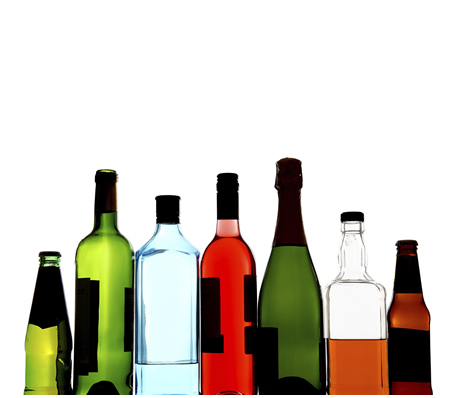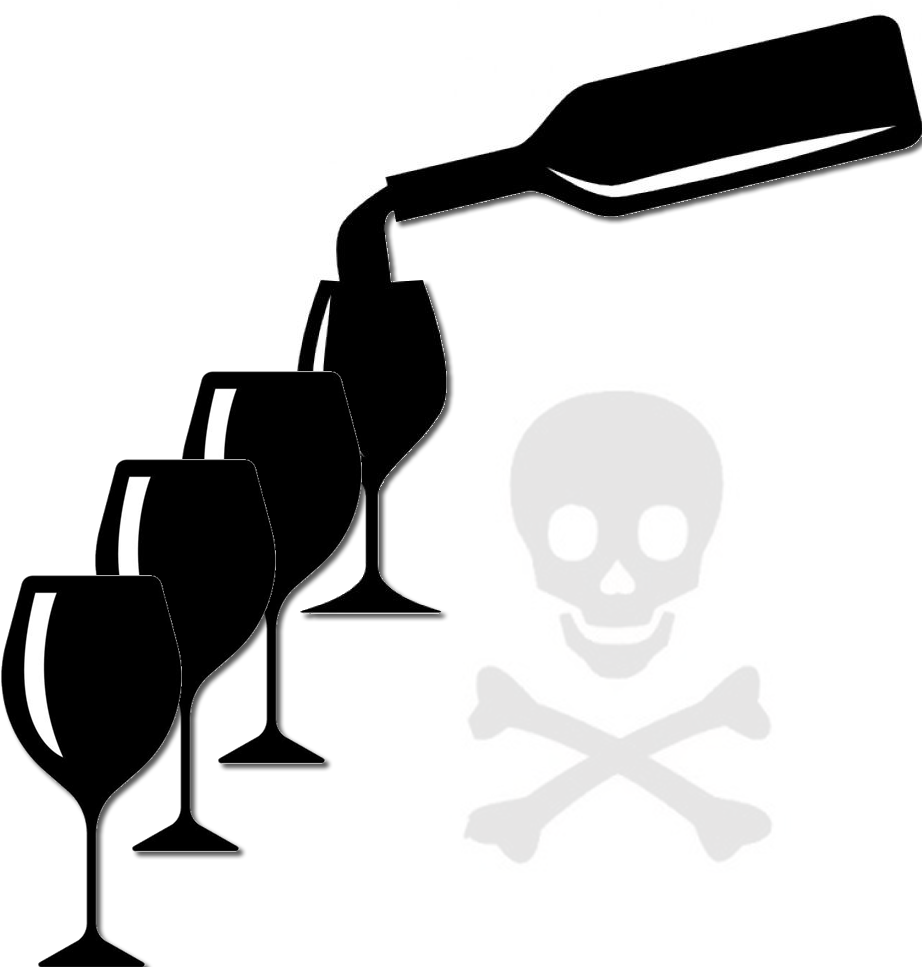ALCOHOL.
As for how it affects the mind, it is best understood as a drug that reduces a person’s ability to think rationally and distorts his or her judgment.
Although classified as a depressant, the amount of alcohol consumed determines the type of effect.
Most people drink for the stimulant effect, such as a beer or glass of wine taken to “loosen up.” But if a person consumes more than the body can handle, they then experience alcohol’s depressant effect. They start to feel “stupid” or lose coordination and control.
Alcohol overdose causes even more severe depressant effects (inability to feel pain, toxicity where the body vomits the poison, and finally unconsciousness or, worse, coma or death from severe toxic overdose). These reactions depend on how much is consumed and how quickly.
There are different kinds of alcohol. Ethyl alcohol (ethanol), the only alcohol used in beverages, is produced by the fermentation of grains and fruits.
Fermenting is a chemical process whereby yeast acts upon certain ingredients in the food, creating alcohol.
Alcohol content
fermented drinks.
such as beer and wine, contain from 2% clcohol to 20% clcohol. Distilled drinks, or liquor, contain from 40% to 50% or more alcohol.
Although classified as a depressant, the amount of alcohol consumed determines the type of effect.
Most people drink for the stimulant effect, such as a beer or glass of wine taken to “loosen up.” But if a person consumes more than the body can handle, they then experience alcohol’s depressant effect. They start to feel “stupid” or lose coordination and control.
Alcohol overdose causes even more severe depressant effects (inability to feel pain, toxicity where the body vomits the poison, and finally unconsciousness or, worse, coma or death from severe toxic overdose). These reactions depend on how much is consumed and how quickly.
There are different kinds of alcohol. Ethyl alcohol (ethanol), the only alcohol used in beverages, is produced by the fermentation of grains and fruits.
Fermenting is a chemical process whereby yeast acts upon certain ingredients in the food, creating alcohol.
Alcohol content
fermented drinks.
such as beer and wine, contain from 2% clcohol to 20% clcohol. Distilled drinks, or liquor, contain from 40% to 50% or more alcohol.

DABBING
AIcohol is absorbed into the bloodstream via small blood vessels in the walls of the stornach ondmall bintestine. Within minutes of drinking alcohol, it travels from the stomach to the brain, where it quickly produces its effects, slowing the action of nerve cells.
Approximately 20% of alcohol is absorbed through the stomach.
Most of the remaining 80% is absorbed through the small intestine.
Alcohol is also carried by the bloodstream to the liver, which eliminate the alcohol from the blood through a process called “metabolizing,” where it is converted to a non-toxic substance. The liver con only metabolize a certain amount at a time, leaving the excess circulating throughout the body. Thus the intensity of the effect on the body is directly related to the amount consumed.
When the amount of alcohol in the blood exceeds a certain level, the respiratory (breathing) system slows down markedly, and can cause a coma or death, because oxygen no longer reaches the brain.
Approximately 20% of alcohol is absorbed through the stomach.
Most of the remaining 80% is absorbed through the small intestine.
Alcohol is also carried by the bloodstream to the liver, which eliminate the alcohol from the blood through a process called “metabolizing,” where it is converted to a non-toxic substance. The liver con only metabolize a certain amount at a time, leaving the excess circulating throughout the body. Thus the intensity of the effect on the body is directly related to the amount consumed.
When the amount of alcohol in the blood exceeds a certain level, the respiratory (breathing) system slows down markedly, and can cause a coma or death, because oxygen no longer reaches the brain.

What is binge drinking.
Binge drinking is the practice of consuming large quantities of alcohol in a single session, usually defined as five or more drinks at one time for a man, or four or more drinks at one time for a woman.
About 90% of the alcohol consumed by youth under the age of 21 in the United States is in the form of binge drinks.
What is alcoholism or alcohol dependence?
Alcohol dependence (alcoholism) consists of four symptoms:
• Craving: a strong need, or compulsion, to drink.
• Loss of control: the inability to limit one’s drinking on any given occasion.
• Physical dependence:
withdrawal symptoms, such as nausea, sweating, shakiness, and anxiety, occur when alcohol use is stopped after a period of heavy drinking.
Serious dependence can lead to life-threatening withdrawal symptoms including convulsions, starting 8 to 12
hours after the last drink. The delirium tremens (D.T.:’s) begins 3 to 4 days later where the person becomes extremely agitated, shakes, hallucinates and loses touch with reality.
• Tolerance: The need to drink greater arounts of alcohol in order to get high.
An increasingly heavy drinker often says he could stop whenever he chooses he just never “chooses” to do so. Alcoholism is not a destination, but a progression, a long road of deterioration in which life continuously worsens.
About 90% of the alcohol consumed by youth under the age of 21 in the United States is in the form of binge drinks.
What is alcoholism or alcohol dependence?
Alcohol dependence (alcoholism) consists of four symptoms:
• Craving: a strong need, or compulsion, to drink.
• Loss of control: the inability to limit one’s drinking on any given occasion.
• Physical dependence:
withdrawal symptoms, such as nausea, sweating, shakiness, and anxiety, occur when alcohol use is stopped after a period of heavy drinking.
Serious dependence can lead to life-threatening withdrawal symptoms including convulsions, starting 8 to 12
hours after the last drink. The delirium tremens (D.T.:’s) begins 3 to 4 days later where the person becomes extremely agitated, shakes, hallucinates and loses touch with reality.
• Tolerance: The need to drink greater arounts of alcohol in order to get high.
An increasingly heavy drinker often says he could stop whenever he chooses he just never “chooses” to do so. Alcoholism is not a destination, but a progression, a long road of deterioration in which life continuously worsens.

Short-term effects
Depending
On how much is taken and the physical condition of the individual, alcohol can cause:
• Slurred speech
• Drowsiness
• Vomiting
• Diarrhea
• Upset stomach
idaches reathing difficulties
Distorted Vision and hearing
• Impaired judgment
• Decreased perception and coordination
• Unconsciousness
• Anemia
doss of red blood cells)
• Coma
• Blackouts (memory lapses, where the drinker cannot remember events that occurred while under the influence)
• Slurred speech
• Drowsiness
• Vomiting
• Diarrhea
• Upset stomach
idaches reathing difficulties
Distorted Vision and hearing
• Impaired judgment
• Decreased perception and coordination
• Unconsciousness
• Anemia
doss of red blood cells)
• Coma
• Blackouts (memory lapses, where the drinker cannot remember events that occurred while under the influence)

Long-term effects
• Intentional injuries such as firearm injuries, sexual assault, domestic violence
• Increased on-the-job injuries and loss of productivity
• Increased family problems, broken relationships
• Alcohol poisoning
• High blood pressure, stroke, and other heart-related diseases
Liver disease
• Nerve damage
• Sexual problems
• Permanent damage to the brain
Vitamin B, deficiency, which can lead to a disorder characterized by amnesia, apathy and disorientation
• Ulcers
Gastritis (inflammation of stomach walls)
• Malnutrition
• Cancer of the mouth and throat
• Increased on-the-job injuries and loss of productivity
• Increased family problems, broken relationships
• Alcohol poisoning
• High blood pressure, stroke, and other heart-related diseases
Liver disease
• Nerve damage
• Sexual problems
• Permanent damage to the brain
Vitamin B, deficiency, which can lead to a disorder characterized by amnesia, apathy and disorientation
• Ulcers
Gastritis (inflammation of stomach walls)
• Malnutrition
• Cancer of the mouth and throat

